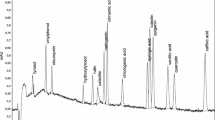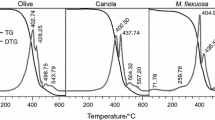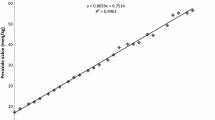Abstract
The antioxidant effects of hydrophilic phenols and tocopherols on the oxidative stability in virgin olive oils and in purified olive oil have been evaluated. Total hydrophilic phenols and the oleosidic forms of 3,4-dihydroxyphenolethanol (3,4-DHPEA) were correlated (r=0.97) with the oxidative stability of virgin olive oil. On the contrary, tocopherols showed low correlation (r=0.05). Purified olive oil with the dialdehydic form of elenolic acid linked to 3,4-DHPEA, an isomer of oleuropeine aglycon, and 3,4-DHPEA had good oxidative stability. A synergistic effect was observed in the mixture of 3,4-DHPEA and its oleosidic forms with α-tocopherol in purified olive oil by the Rancimat method at 120°C.
Similar content being viewed by others
References
Tiscornia, E., M. Forina, and F. Evangelisti. Composizione chimica dell’olio di oliva e sue variazioni indotte dal processo di rettificazione,Riv. Ital. Sost. Grasse 59:519–556 (1982).
Löliger, J., Natural Antioxidants, inRancidity in Foods, edited by J.C. Allen and R.J. Hamilton, Applied Science Publishers, London, 1983, pp. 89–107.
Vazquez Roncero, A., C. Janer Del Valle, and L. Janer Del Valle, Deferminaciòn de los polifenoles totales del aceite de oliva,Grasas Aceites 24:350–355 (1973).
Vazquez Roncero, A., L. Janer Del Valle, and C. Janer Del Valle, Componentes fenòlicos de la aceituna. III. Polifenoles del aceite,27:185–191 (1976).
Montedoro, G.F., I costituenti fenolici presenti negli oli vergini di oliva,Sci. Tecnol. Alimenti 2:177–186 (1972).
Montedoro, G.F., M. Servili, M. Baldioli, R. Selvaggini, E. Miniati, and A. Macchioni, Simple and Hydrolyzable Phenolic Compounds in Virgin Olive Oil; Note 3. Spectroscopic Characterization of the Secoroidoid Derivatives.J. Agric. Food Chem. 41:2228–2234 (1993).
Montedoro, G.F., and C. Cantarelli, Investigation on Olive Oil Phenolic Compounds,Riv. Ital. Sost. Grasse 46:115–124 (1969).
Vasquez Roncero A, Les polyphénols de l’huile d’olive et leur influence sur les caractéristiques de l’huile,Revue Franc. Corps Gras 25:21–26 (1978).
Chimi, H., A. Sadik, B. Le Tutour, and M. Rahamani, Contribution à l’étude comparative des pouvoirs antioxidants dans l’huile d’olive du tyrosol, de l’hydrosytyrosol, de l’acide caffeique, de l’oleuropeine et du B.H.T.,35:339–344 (1988).
Servili, M., and G.F. Montedoro, Recupero dei polifenoli dalle acque di vegetazione delle olive e valutazione del loro potere antiossidante,Industrie alimentari 28:14–19 (1989).
Papadopoulos, G., and D. Boakou, Antioxidant Effect of Natural Phenols on Olive Oil,J. Am. Oil Chem. Soc. 68:669–671 (1991).
Chimi, H., J. Cillard, P. Cillard, and M. Rhamani, Peroxyl and Hydroxyl Radical Scavenging Activity of Some Natural Phenolic Antioxitants,68:307–311 (1991).
Montedoro, G.F., M. Servili, M. Baldioli, and E. Miniati, Simple and Hydrolyzable Phenolic Compounds in Virgin Olive Oil; Note 2. Initial Characterization of the Hydrolyzable Fraction,J. Agric. Food Chem. 40:1577–1580 (1992).
Servili, M., M. Baldioli, E. Miniati, and G.F. Montedoro, Antioxidant Activity of New Phenolic Compouds Extracted from Virgin Olive Oil and Their Interaction with α-tocopherol and β-Carotene, inAbstracts of the 9th World Congress of Food Science and Technology July 30–August 4, 1995, Budapest, p. 38.
Pratt, D.E., and B.J.F. Hudson, Natural Antioxidants Not Exploited Commercially, inFood Antioxidants, edited by B.J.F. Hudson, Elsevier Applied Science, London, 1990, pp. 171–191.
Chen, Q., H. Shi, and C.-T. Ho, Effects of Rosemary Extracts and Major Constituents on Lipid Oxidation and Soybean, Lipoxygenase Activity,J. Am. Oil Chem. Soc. 69:999–1002 (1992).
Rossel, B., Measuring Resistance to Oxidative Rancidity,Lipid Tech. 2:39–44 (1992).
Rossell, J.B., Measurement of Rancidity, inRancidity in Foods, edited by J.C. Allen and R.J. Hamilton, Blackie Academic & Professional, Glasgow, 1994, pp. 22–53.
Official Methods and Recommended Practices of the American Oil Chemists’ Society, edited by D. Firestone, American Oil Chemists’ Society, 1991, Method Cd 12–57.
Laubli, M., and P.A. Bruttel, Determination of the Oxidative Stability of Fats and Oils: Comparison Between the Active Oxygen Method and the Rancimat Method,J. Assoc. Oil Chem. Soc. 63:792–798 (1986).
Laubli, M.W., P.A. Bruttel, and E. Schalch, Determination of the Oxidative Stability of Fats and Oils. Comparison Between the Active Oxygen Method AOM and Rancimat Method,Fat Sci. Technol. 90:56–58 (1988).
Gordon, M.H., and E. Mursi, A Comparison of Oil Stability Based on the Methrom Rancimat with Storage at 20°C,J. Am. Oil Chem. Soc. 71:649–651 (1994).
Lee, E.C., and D.B. Min, Quenching Mechanism of β-Carotene on the Chlorophyll Sensitized Photoxidation of Soybean Oil,J. Food Sci. 53:1894–1895 (1988).
Baraldi, P.G., D. Simoni, F. Manfredini, and E. Menziani, Preparation of 3,4-Dihydroxy-1-benzeneethanol: A Reinvestigation,Liebigs Ann. Chem. 684–686 (1983).
Montedoro, G.F., M. Servili, M. Baldioli, and E. Miniati, Simple and Hydrolyzable Phenolic Compounds in Virgin Olive Oil; Note 1. Their Extraction Separation and Quantitative and Semiquantitative Separation and Evaluation by HPLC,J. Agric. Food Chem. 40:1571–1576 (1992).
Carpenter, J.R., Determination of Tocopherols in Vegetable Oils,J. Am. Oil Chem. Soc. 56:668–671 (1979).
EC 1991 Commission Regulation EC No 2568/91 July 11, 1991, Official EC Journal L 81 21.10.1991.
Statgraphics version 6, STSC, Inc: Maryland, 1992.
SIMCA-S version 5. 1, UMETRI AB, Umeå, Sweden, 1994.
Martens, M., and H. Martens, Partial Least Squares Regression, inStatistical Procedures in Foods Research, edited by J.R. Piggott, Elsevier Applied Science, London, 1986, pp. 293–359.
Servili, M., M. Baldioli, A.L. Begliomini, and G.F. Montedoro, Effetti dei complessi colloidali e dell’attività enzimatica endogena delle olive sulla composizione chimica degli oli vergini di oliva,Proceedings of the 2nd Italian Congress of Food Science and Technology, Cernobbio, Italy, 21–22 September 1995 (in press).
Boguth, W., R. Repges, and R. Zell, Aspects of the Action of Vitamin E,Int. Z. Vit. Forshung. 40:323–330 (1970).
Schuler, P. Natural Antioxidants Exploited Commercially, inFood Antioxidants, edited by B.J.F. Hudson, Elsevier Applied Science, London, 1990, pp. 99–170.
Author information
Authors and Affiliations
About this article
Cite this article
Baldioli, M., Servili, M., Perretti, G. et al. Antioxidant activity of tocopherols and phenolic compounds of virgin olive oil. J Am Oil Chem Soc 73, 1589–1593 (1996). https://doi.org/10.1007/BF02523530
Received:
Accepted:
Issue Date:
DOI: https://doi.org/10.1007/BF02523530




